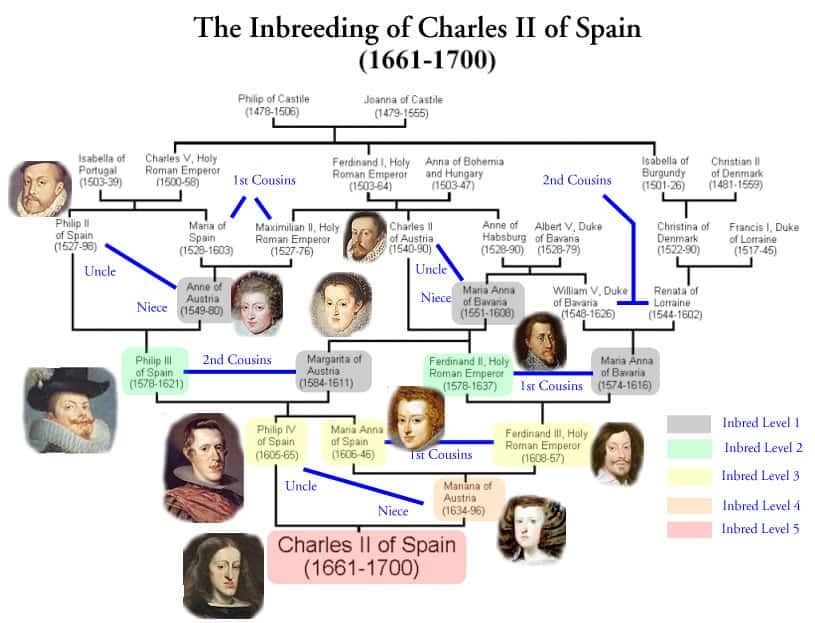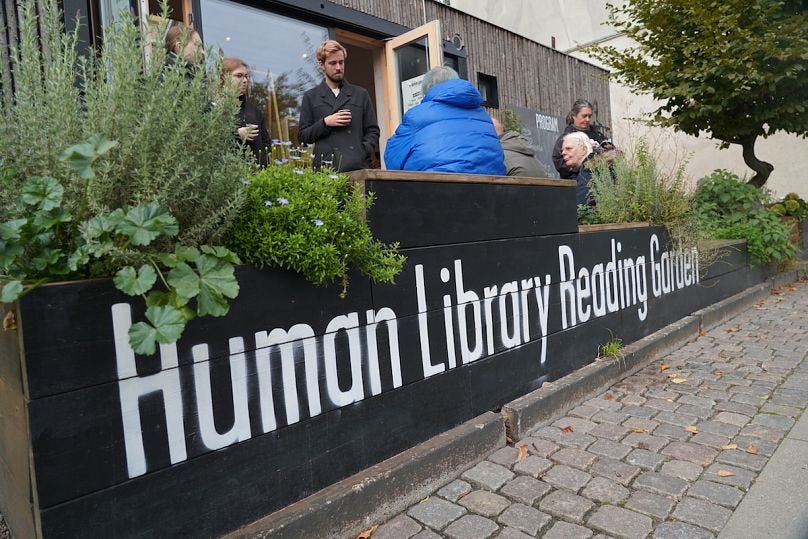The Habsburgification of America: When Political Monoculture Breeds Collapse
How ideological inbreeding & demographic monoculture leads to the extinction of excellence
Preface
I know many of you are feeling overwhelmed, anxious about the daily headlines, powerless in the face of systemic forces that seem rigged against progress. You’re not alone.
This piece isn’t just another rant—it’s part of an ongoing series asking: How did we get here? It’s an invitation to look beneath the surface, to understand the mindsets driving collapse beyond surface-level criticism, to trace the hidden patterns and root causes shaping our moment, and to reclaim our agency by building more resilient, inclusive systems.
With the sad news breaking of President Biden’s cancer diagnosis, we’re once again witnessing a political media ecosystem so mired in their ulterior motives for views and desperate to avoid retaliation from the MAGA machine that it overcorrects—relentlessly attacking Biden’s age, health, and fitness, while largely ignoring or normalizing the open authoritarianism, instability, and rot (not to mention visible mental decline) emanating from Trump.
But this isn’t a media critique. It’s a systemic one. The media’s behavior (e.g., Jake Tapper’s latest book and media blitz) is a symptom of a deeper pathology which I explore in this piece: a closed, inbred, self-reinforcing system that rewards loyalty over competence, entrenched power over new voices, and dynasty over decency. A system not unlike the one that doomed the Habsburg Empire. The rot isn’t surface-level. It’s deep-rooted, self-replicating, and already unraveling the system from within.
If democracy is to survive, we have to stop treating the symptoms as isolated. We have to understand how closed systems collapse, and how to build ones that don’t.
Two Images, Two Americas
I still remember watching with pride the US women’s gymnastics team at the 2024 Paris Olympics. Our gold-medalists stood on the podium as living proof of what makes America great—strength through diversity—80% of its members are women of color, spanning Black, Asian, and Latina backgrounds.
Now fast-forward to this past week: the Trump regime flew in its first wave of White South African “refugees” (don’t quality as real refugees under the UN definition) on a chartered jet with plenty of suitcases and full bellies in tow—no standard vetting, no proof of danger—while stopping all other asylum requests and canceling the protected legal status of the many brave Afghanis who risked their lives and defied the Taliban to work with the US military, betraying our promise to keep them. In other words, whiteness gets the fast pass, everyone else gets a wall. It’s the same move closed royal courts made centuries ago: protect your own bloodline, cut out everyone else, ensuring political monoculture and purity over genuine solidarity.
Like those doomed royal houses, MAGA-era conservatives appear determined to concentrate power among a homogeneous monoculture—straight, white, Christian men— while rejecting diversity that underpins resilience. But both history and science warn us that such inbreeding (be it literal or metaphorical) invariably produces weakness and eventual collapse, just as it did for the once-mighty Habsburgs and other royal houses that prized purity over adaptability.
Part I: The Science and History of Closed Systems
The Habsburg Lesson: When Purity Leads to Extinction
The Habsburg dynasty offers perhaps history's most striking lesson in the dangers of homogeneity. For centuries, this royal family built their imperial power through strategic marriage, but eventually took inbreeding to catastrophic extremes. The Habsburgs systematically married within their family—first cousins, uncles to nieces, and close relatives—all to preserve wealth and power within their bloodline.
This strategy initially expanded their empire across Europe, but ultimately led to their demise. By the 17th century, the infamous "Habsburg jaw" and other physical deformities had become visible manifestations of genetic decline. Charles II of Spain, the dynasty's last ruler, embodied the consequences of sixteen generations of inbreeding: physically and mentally incapacitated by recessive genetic disorders, he was unable to produce heirs. When he died in 1700, the entire Habsburg line died with him.

From Royal Courts to Extinction Bursts
But the Habsburg case is no isolated incident. The Ptolemaic dynasty of Egypt enforced sibling marriages as official state policy to not dilute wealth and power. Despite producing figures like Cleopatra, their increasingly closed genetic pool contributed to instability, paranoia, and in-fighting that weakened their rule. George R.R. Martin famously used the Ptolemaic dynasty as inspiration for the Targaryens in Game of Thrones.
History shows that the more closed and “pure” a ruling system, the weaker it becomes. This is a classic reinforcing feedback loop: less diversity → more vulnerabilities → more purity rituals → faster decline.
And of course, it’s not just genetics. In political and demographic monocultures, ideas reproduce the same way—sealed power structures choke out fresh perspectives, just as sealed gene pools invite collapse.
In biology, that final, frantic struggle to reproduce before extinction is called an “extinction burst.” Today’s Trump regime mirrors that behavior: fast-tracking white South African “refugees,” gutting voting rights, accelerating deportation of Latino communities, eliminating DEI and punishing diversity—a desperate lunge by a dying in-group. But like any extinction burst, it signals an unstoppable path to collapse, only in this case, it’s self-inflicted.
The Science of Diversity and Resilience
The Habsburg metaphor is more than a historical curiosity; it reflects fundamental principles of biological and social systems. In genetic terms, as we all know, closed breeding pools inevitably accumulate hidden weaknesses. With no introduction of new genetic material, recessive disorders multiply and eventually propagate. This explains why responsible animal breeders carefully avoid overbreeding and why natural selection favors genetic diversity. It’s like 19th-century Ireland, planting nothing but potatoes: one blight, and millions starve. In both cases, monoculture—whether of crops or of people—always backfires.
Polyculture in Practice: The Three Sisters
Long before modern permaculture, Indigenous farmers in North America planted corn, beans, and squash together—what they called the “Three Sisters.” Corn provides a trellis for beans, beans fix nitrogen to nourish the soil, and squash shades out weeds while retaining moisture. This interlocking system yields far more resilience, fertility, and yield than any single crop grown alone—nature’s original blueprint for diversity.
Polyculture in the Workplace
But this principle extends beyond genetics to social systems. Research in organizational psychology shows that diverse groups consistently outperform homogeneous ones in problem-solving, innovation, and adaptation. McKinsey's comprehensive business studies demonstrate that companies with diverse leadership teams are 35% more likely to outperform their competitors. This advantage stems from cognitive diversity—the presence of multiple perspectives enables groups to identify blind spots, generate more solutions, and avoid groupthink.
During my fieldwork with grassroots communities across Guatemala, Ghana, Kenya, and India, I've observed how technological innovation flourishes precisely where traditional knowledge systems intersect with modern approaches—the opposite of what happens in ideologically isolated think tanks.
The mechanisms linking diversity to resilience operate across levels of organization:
Adaptive Capacity: Diverse systems possess a wider range of responses to environmental challenges
Information Processing: Multiple perspectives reduce collective blind spots
Innovation Potential: The recombination of different ideas and approaches generates novel solutions
Error Correction: Diverse groups more effectively identify and correct mistaken assumptions
America's Own Dynastic Purity Laws
America has its own dynastic purity laws. Jim Crow segregation, housing discrimination through redlining, exclusionary covenants, and "sundown towns" functioned as America's version of Habsburg strategic marriages—legal and extra-legal mechanisms explicitly designed to corral Black, Indigenous, Brown, and other people of color into under-resourced geographies while concentrating wealth and power in White hands.
In urban planning terms, it’s called Spatial Apartheid, which protected the multi-century wealth transfer from slavery to the suburbs: redlining, exclusionary covenants, and “sundown towns” channeled home-loan capital and rising property values into white hands while locking out families of color. Modern dispossession tools, such as civil forfeiture seizures and mass deportations, replicate that logic, stripping assets and tearing apart immigrant and low-income communities. These were deliberate power plays: when Brown v. Board forced school integration in 1954, entire Virginia districts shut down rather than comply, backed by White Citizens’ Councils of local elites. Like Habsburg marriage contracts, these policies have bound wealth and power into a narrow demographic, starving the broader population of generational opportunity.
While McKinsey shows how diversity boosts business performance, public health research reveals the devastating human toll of white supremacy's own "genetic disorders." Studies from the American Journal of Public Health demonstrate that racially segregated neighborhoods yield cumulative health, education, and economic losses over generations. Residential segregation and spatial apartheid doesn’t just harm communities of color—it drains white households too. Brookings Institute (citing McKinsey) estimates that continued racial and economic segregation will shave 4–6% off US GDP by 2028, ~$1.2–$2 trillion, by hindering consumption and investment, while white Americans pay an extra “segregation tax” in the form of inflated housing premiums to live in so‑called exclusive enclaves. And a recent population‑health study found that both Black and White children in highly segregated neighborhoods report poorer self‑rated health, showing that segregation’s toll on well‑being cuts across racial lines.
These principles explain why monocultures—whether genetic, agricultural, or ideological or demographic—are inherently brittle, while polycultures regenerate. Monocultures may appear strong during stable periods, but collapse rapidly when faced with unexpected challenges. The Habsburg dynasty's downfall wasn't just bad luck—it was the inevitable consequence of a system that systematically eliminated diversity in pursuit of “purity.”
The Ongoing Legacy: Importing Apartheid-Supporters in 2025
This past week, the Trump regime began admitting its first wave of White South African "refugees" under an expedited, unprecedented process – flying nearly 60 Afrikaners into Dulles on a government-chartered jet only weeks after Trump's executive order, even as the broader refugee program remains frozen.
These arrivals weren't vetted on merit or clear threat of persecution; they were fast-tracked for one reason alone: whiteness. Under the 1951 UN Refugee Convention, true refugees must face "a well-founded fear of persecution" based on race, religion, nationality, political opinion or group membership – criteria Afrikaners overwhelmingly fail to meet, since they remain the wealthiest and most privileged demographic in South Africa whose only “grievance” was no longer able to benefit from Apartheid and continue oppressing. Case in point, one of the first arrivals, Charl Kleinhaus, was exposed by The Guardian for a trove of antisemitic and racist posts.
Meanwhile, mainstream white South Africans and the country’s courts have publicly rejected the "white genocide" narrative, labeling these Afrikaner applicants as sore losers nostalgic for apartheid and unqualified for genuine asylum. Many arrived expecting handouts rather than work – a bitter echo of Habsburg nobles living on entitlement rather than enterprise. By prioritizing skin color over competence or need, the US is writing its own playbook for modern monoculture: a political inbreeding that sacrifices integrity, solidarity and long-term resilience on the altar of racial purity.
Thank you for reading! To further support my efforts and if you’re able to, consider upgrading to a paid subscription for less than a cup of coffee a month. I’m deeply appreciative of your support!
Part II: America's Modern Habsburg Tendency
The Purity Doctrine Unmasked in Today’s Politics
In the past 18 months, several MAGA-aligned pastors and youth leaders have been indicted on sexual-offense charges involving minors, undermining their own “family values” rhetoric and illustrating how closed-system purity breeds exploitation.
Multiple high-profile figures within the MAGA movement, often positioned as moral authorities, have faced criminal charges for abusing children in their congregations or ministries. MAGA’s crusade for “family values” collapses under its own contradictions, just like Habsburg inbreeding, obsession with purity breeds decay:
Leader ≠ Moral Standard: 34x convicted felon Trump is an adjudicated rapist and found liable for sexual abuse in federal court, yet his devoted evangelical “family-values” followers treat him as divine.
Ideological Closure as Reproductive Policy: Calls to ban or criminalize gender-affirming care and restrict reproductive freedom aren’t merely cultural stances—they’re birth-rate levers. By driving down fertility among women of color and LGBTQ+ families while promoting “traditional” large-family incentives for straight, Christian couples, this movement is practicing demographic engineering—boosting their preferred population and shrinking everyone else.
Information Isolation as Cultural Quarantine: The same folks who crown Trump “the birthright of straight, white, Christian men” are sealing off media, weaponizing think tanks (think Heritage Foundation), banning books and closing off schools from outside ideas—effectively quarantining their preferred demographic from any worldview that might challenge their grip on power. Moreover, the state of Oklahoma has recently announced that they will begin teaching the false conspiracy theory (as fact) that the 2020 election of Joe Biden was rigged. This is indoctrination at its most dangerous.
Institutions Cannibalize Themselves: Churches and ministries that shout strict moral codes are the same ones cycling through youth-leader abuse scandals we so often see in the headlines. Squashing dissent only buries the rot until it explodes.
Policy Snapback: Even their economic and healthcare agendas—sold as pro-American—backfire on their base, shredding prosperity and wellness. But we’ve seen this script: closed systems can’t course-correct.
Denaturalization as Ethnic Cleansing: Now, the Trump regime has even proposed a denaturalization purge—stripping citizenship from naturalized immigrants en masse, particularly refugees from Muslim-majority countries and war-torn regions. This plan would single out millions of lawful US citizens for removal, remaking the electorate by revoking rights rather than granting them .
Immigration enforcement is far more central to the second Trump administration than it was to the first. We can see this in how the administration has made ideological issues the basis of visa revocations. Such an agenda fits with the white Christian nationalism of many MAGA supporters, and it provides a legal route to cast out those citizens that they do not want in their imagined country. Making examples of errant citizens who are brown and Muslim—like the detained green-card holder Mahmoud Khalil—is just the sort of political spectacle that excites Trump’s MAGA base.
— Rafia Zakaria, The Nation
These aren’t isolated tactics—they form a coordinated, multi-domain program of demographic engineering. Political, religious, informational, and legal levers all point toward one goal: reshape the American population into a single, homogeneous bloc. they’re the predictable outcome when you lock out any outside perspective. America’s Habsburgification isn’t just hypocritical; it’s a death sentence for our democracy.
Part III: Breaking the Cycle – From Brittleness to Repair
Historical Precedents for Renewal
White supremacy has historically functioned as America's dynastic inbreeding—not just prejudice, but a multi-century system of power hoarding that breeds brittleness into the very bones of our politics and collective identity. Just as Charles II's body failed from concentrated genetic weakness, our democracy's body suffers metabolic shutdown when it excludes diverse participation. The 'pure' system becomes too weak to solve even basic problems.
But this Habsburg pattern isn't inevitable. Throughout history, societies have successfully transitioned from closed, rigid systems to more open, adaptive ones without losing cohesion. The Byzantine Empire survived for a millennium precisely because it periodically renewed itself through strategic openness while maintaining core institutions. Renaissance Florence thrived by balancing traditional structures with openness to new ideas and diverse influences.
I've witnessed this firsthand in communities across the globe, from Kerala’s Peoples Planning panchayats to participatory budgeting from citizens in Porto Alegre, Brazil, to many elements of what made our own American democracy great, especially at many local levels. Polycultural governance models share a few key traits—broad-based participation, decentralized decision-making, built-in feedback loops, and mechanisms to guard against elite capture. These features foster resilience and adaptability, in stark contrast to monocultural power structures that concentrate authority, shut out dissent, and spiral into rigid uniformity.
Balancing Unity and Diversity: A Path Forward
A healthy democracy needs both unity and diversity—shared purpose combined with different viewpoints and life experiences. This isn't an either/or binary choice. We don't need to pick between complete sameness (which leads to Habsburg-like decline) or chaotic fragmentation (which prevents effective governance). Instead, political scientists suggest a middle path called "constitutional patriotism," where Americans of all backgrounds unite around core democratic values and principles rather than demanding cultural or religious uniformity.
Think of it as the difference between demanding everyone be identical versus asking everyone to follow the same basic rules of the game while bringing their unique talents to the team.
Here are practical ways we can achieve this balance:
1. Design for Difference
Institutional Design: Create advisory boards with diverse perspectives while implementing consultation processes that reach beyond the usual suspects. When city councils include representatives from different neighborhoods and backgrounds, they make better infrastructure decisions that serve the entire community, not just the wealthiest areas.
Participatory Approaches: Involve everyday people in designing the systems that directly affect their lives—from community policing strategies to education policies. When Seattle involved homeless individuals in designing shelter systems, they created solutions that experts had overlooked, resulting in higher utilization rates and better outcomes.
2. Build Community Connections
Bridging Social Capital: Support institutions like public schools, national service programs, and community organizations that bring different people together alongside neighborhood civic salons and virtual forums. Think Denmark’s Human Library, where you interact with a person to hear their life story to “unjudge someone” and address prejudices. Create spaces where Americans can collaborate across divides.
Complete American Stories: Tell narratives that acknowledge multiple contributions to American greatness while honestly confronting difficult chapters in our history. When we teach how the GI Bill helped build the middle class AND how Black veterans were often denied these benefits, we tell a more complete story that explains both American opportunity and persistent inequality.
3. Embrace Productive Growth
Knowledge Humility: Recognize that no single person or group has all the answers and value both expertise and lived experience.
Truth and Reconciliation: Create formal and informal processes to acknowledge historical and ongoing harms without getting stuck in blame. In a previous post, I wrote a deep dive analysis into the Truth & Reconciliation we need but never had in the US, as compared to Germany's confrontation with its Nazi past. It wasn't comfortable, but it was absolutely necessary for creating a healthier democracy.
Your Regenerative Check-In: A Personal Exercise
Take five minutes today for this quick diversity audit of your information ecosystem:
Source Diversity: List the last five news sources you consumed. How similar or different are they in perspective?
Relationship Range: Identify three people in your life who consistently challenge your thinking in constructive ways.
Uncomfortable Growth: What's one historical or current reality that makes you uncomfortable to confront? Sit with that discomfort for two minutes without trying to resolve it. In my teaching of future skills for the 21st century, I often say that being able to hold discomfort is one of the most important, yet undervalued skills. The lack of this ability to hold discomfort is costing us our future.
Regenerative Action: Pick one concrete step this week to broaden your lens—read an author from a different background, attend a community forum on a new topic, or have a respectful conversation with someone whose life experience differs from yours (while firmly rejecting any viewpoint rooted in bigotry, hate or violence).
This simple exercise the personal capacity to incorporate difference without feeling threatened by it.
These approaches help maintain social unity not by forcing everyone to be the same, but by creating frameworks where our differences actually make us collectively stronger and more adaptable. Like a healthy ecosystem that thrives through biodiversity rather than monoculture, a healthy democracy needs both shared principles and diverse perspectives. However, achieving this balance requires the courage to face uncomfortable truths rather than retreating into comforting fictions—a challenge that cuts to the root of our current political divide.
A Choice Between Collapse & Renewal
Our path isn’t predetermined. We can follow the Habsburg route—pursuing purity until our institutions calcify and collapse—or choose principled pluralism, blending core values with diverse perspectives to adapt and thrive.
We all know by now that dynasties that cling to sameness die. The Habsburgs didn’t fall for lack of tradition, but for their refusal to evolve. Our experiment—“E Pluribus Unum”—never meant erasing differences, but harnessing them for collective strength.
What we’re facing as a society is existential. Systems that can’t adapt die, whether in biology, business, or democracy. Faced with climate upheaval, tech disruption, and global shifts, America’s resilience depends on unleashing its full national genius: the distributed intelligence of a diverse people united by shared democratic principles.
We can marry our differences, cultivating democracy the way Indigenous farmers grew their corn, beans, and squash: in harmony and strength, not monoculture and fragility. That’s how America regenerates.
To further support my efforts, consider buying me a coffee each month via a paid subscription. I’m deeply appreciative of your support!
Sources:
Works Cited
Oklahoma High Schools to Teach Election Conspiracy Theories. The Guardian, 17 May 2025.
Redlining and “Spatial Apartheid”. Oxford Research Encyclopedia of American History, Oxford University Press, 2018.
South African Refugee’s Antisemitic Posts Expose White Nationalist Narratives. The Guardian, 15 May 2025.
At Denmark’s Human Library, You Can Read People Like a Book and Unjudge Them. Euronews, 13 Oct. 2021.
Why Diversity Matters. McKinsey & Company, Jan. 2015.
Separate and Unequal Neighborhoods Are Sustaining Racial and Economic Injustice in the U.S.. Brookings Institution, 27 Jan. 2023.
Martin, Andrew, Robert Heard, and Victor S. C. Fung. “Carlos II of Spain, ‘The Bewitched’: cursed by aspartylglucosaminuria?.” BMJ Neurology Open, vol. 3, no. 2, 27 Sept. 2021, e000072.
Smith, John P., et al. “The Relation of Residential Segregation to All-Cause Mortality: A Study in Black and White.” American Journal of Public Health, vol. 90, no. 4, Apr. 2000, pp. 615–17.
House of Habsburg. Wikipedia
Trout, Andrew Lewis. “Extinction.” Encyclopaedia Britannica, 2024.
Zakaria, Rafia. “Trump’s Denaturalization Plan Would Strip Citizenship from Millions.” The Nation 2025
Three Sisters (agriculture). Wikipedia
Shahan, Timothy A., and Matias Avellaneda. “The Extinction Burst: Effects of Reinforcement Magnitude.” Journal of the Experimental Analysis of Behavior, vol. 123, no. 2, Mar. 2025, pp. 312–323.
The Perils of Monoculture. Sentient Media, 2023.







